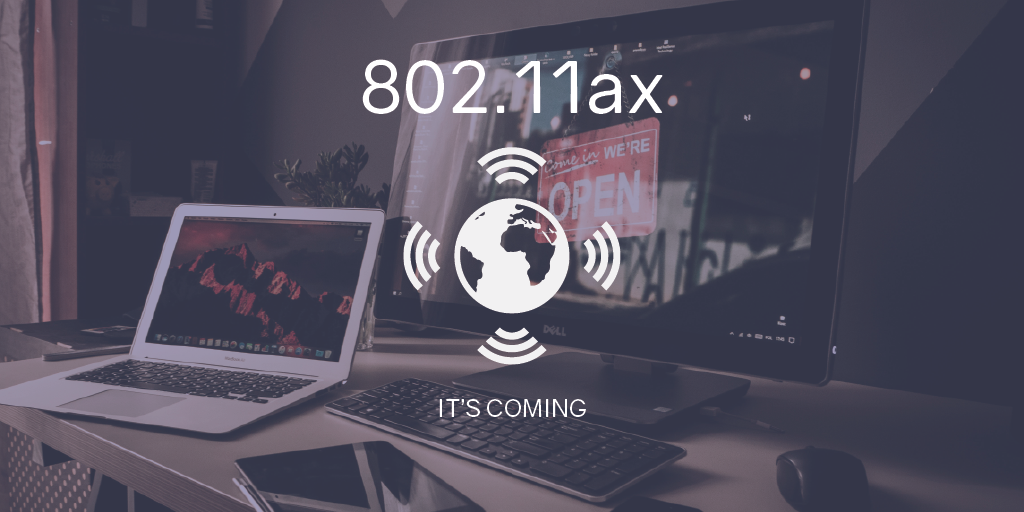Wireless is Getting an Upgrade: High Efficiency Wireless is Coming
December 3, 2018 •Chris Reynolds

802.11ax - High Efficiency Wireless (HEW) is coming! What does that mean for you? Over the last several years, wireless has moved from being a luxury technology to a business impacting need. 802.11ax is the new developing wireless standard that is designed to work at enhancing both 2.4GHz and 5GHz frequencies where 802.11AC/AC2 only had increased efficiencies on the 5GHz. The new standard builds on some of the technologies that were created in the current 802.11ac technologies and borrows some technologies from modern LTE and 5G cellular technologies to build a more robust and efficient wireless future.
 The increasing types of wireless devices that share the wireless network and airspace have varying needs. We have mixtures of IP-Telephony, laptops, cell phones, tablets, IoT devices, 4k video, and high-density collaboration devices all utilizing wireless at the same time. Each of these devices have their own payload, latency, and jitter requirements that they need to function correctly. This becomes a balancing act for wireless systems and the engineers that deploy them to provide the needs of various devices while trying to keep the wired network, and the available airspace in control. What if your wireless network was able to help with the balance of how the airspace is viewed by the wireless system? What if your wireless technology could handle the way data is transmitted and received over the wireless more efficiently? The 802.11ax standard is moving in this direction with some great technology enhancements.
The increasing types of wireless devices that share the wireless network and airspace have varying needs. We have mixtures of IP-Telephony, laptops, cell phones, tablets, IoT devices, 4k video, and high-density collaboration devices all utilizing wireless at the same time. Each of these devices have their own payload, latency, and jitter requirements that they need to function correctly. This becomes a balancing act for wireless systems and the engineers that deploy them to provide the needs of various devices while trying to keep the wired network, and the available airspace in control. What if your wireless network was able to help with the balance of how the airspace is viewed by the wireless system? What if your wireless technology could handle the way data is transmitted and received over the wireless more efficiently? The 802.11ax standard is moving in this direction with some great technology enhancements.
At a high level, 802.11ax is using several technologies to increase the wireless efficiencies from where we are today with the current technology. These technologies are being built upon existing 802.11ac and some added cellular technologies allow for enhancement features such as:
- OFDMA – The ability to divide wireless frequency channels into smaller sized frequency “chunks” to allow different packet sizes to be sent to several devices at the same time. This allows the data transmissions sent to multiple clients at the same time during a transmission opportunity. (TXOP) This is to be supported on both the Uplink and Downlink transmissions, where it is only supported on the downlink today. This will also provide a more granular controller for QOS mechanisms such as bandwidth, delay, and jitter.
- Increased Modulation type (QAM-1024) to help increase much higher speed bursts. This increase in modulation is inherently affected by distance, but additional AP antennas, and new standards-based beamforming will help counter this to provide further distance support for the new rates (MCS 10/11)
- Flexible Wake-Up Times This will allow for the enhanced “sleep mode” of client devices. Where previously client devices would wake up at certain timeslots to listen for AP beacons and receive buffed packets for them, now 802.11ax will allow the scheduling of these wake-up times which can greatly benefit device battery life. Not limited to, but particularly smartphones, tablets, and IoT devices.
- OBSS-PD (Overlapping Basic Service Set – Packet Detection)(aka – coloring) will essentially allow the communication between an AP and clients in a coverage cell to disregard overlapping cell transmissions from neighboring cells beyond a specified threshold.
So, when is 802.11ax coming? At this point, the IEEE/WiFi-Alliance have delivered several drafts of this new standard as it has been more defined and refined over the past couple of years. Currently it is slated for the final draft to be completed and approved later in 2019. With that, some pre-draft devices are starting to pop up, with new releases expected to start ramping up early to mid-2019. Keep in mind that as a ratification may change or update, most of those changes will be deployed as software upgrades in the future.
When should you look to move to this new technology? If you are looking to upgrade your wireless at this time, there are plenty of good solutions still with the Cisco/Meraki 802.11ac Wave 2 portfolios that will provide a great upgrade to most environments today. The current generation of 802.11ac access points are well established and will be supported for years to come. If you are looking to be on that cutting edge of technology or want to have a longer supported solution for upcoming projects that is going to further evolve then maybe you consider holding off for the 802.11ax models to become established. If you have an existing 802.11ac deployment, there is no rush to look at upgrading right away, give 802.11ax a little time to get established and settled in.
A few key thoughts to keep in mind as we close out this topic (for now) and look the future:
- The current 802.11ac solutions are still a viable wireless solution
- 11ax is fully compatible with previous wireless technologies. (802.11a/b/g/n/ac) - if you were looking to upgrade to the newest technology you can be comfortable in knowing that it will still support all devices that are out there today. Just keep in mind that realizing the full 802.11ax efficiencies will come in the future as your clients adopt the new standard as well.
- 11ax access points will become more prevalent soon, but what about the clients? You should not expect to start seeing client devices support 802.11ax until much later in 2019 and ramping up more into 2020. The average consumer upgrades their personal devices around 12-18 months, and that is dependent on when the vendor starts to integrate 802.11ax into their offerings.
An additional consideration for planning... don't forget your underlying infrastructure. If you are not to the point that you are looking at upgrading your wireless network just yet, don’t forget the rest of your network. Now may be the time that you look at budgeting upgrades to your wired infrastructure to be able to handle your future wireless upgrades. With the new wireless technology and the increases in the use of 4K video, VR/AR, and IoT; there is a real potential now to benefit from having the multi-gig (MGIG - 2.5, 5, 10G speeds over Cat5e, Cat6 cabling) speed capability on your AP to Switch uplinks. The switching is available now to upgrade to the 10G+ backbone where you do not currently have it in place. Additionally, the support for N-BaseT (MGIG) switching to be added in areas that will terminate your access points within your site(s).
In the end, this new technology is coming, and it will be here before we know it. Do you need it right now? That all depends on your individual situation and future planning. However, we do know that it is coming both in technology, and the future demands of the network. The famous line in “Field of Dreams”, is “If you build it, they will come…”. As we know with technology, if we do not build it, they are still going to come.
Get Updates
Featured Articles
Categories
- AI (1)
- Automated Technology (4)
- Cisco (8)
- Cisco News (1)
- Cloud Networking (1)
- Collaboration (16)
- CyberSecurity (6)
- Data Center (27)
- DNA (1)
- Education (3)
- Encryption (1)
- Enterprise Networking (23)
- Full-Stack (1)
- Future (1)
- healthcare (2)
- Innovative Technology (11)
- Internet of Things (1)
- Managed Services (3)
- Modern Data Center (2)
- Observability (1)
- Ransomware (1)
- SchoolTechnology (6)
- SD-WAN (1)
- Security (32)
- security strategy (3)
- Telehealth (3)
- Video (1)


